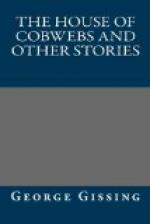The time has not yet come to write the history of his career—fuliginous in not a few of its earlier phases, gathering serenity towards its close,—finding a soul of goodness in things evil. This only pretends to be a chronological and, quite incidentally, a critical survey of George Gissing’s chief works. And comparatively short as his working life proved to be—hampered for ten years by the sternest poverty, and for nearly ten more by the sad, illusive optimism of the poitrinaire—the task of the mere surveyor is no light or perfunctory one. Artistic as his temperament undoubtedly was, and conscientious as his writing appears down to its minutest detail, Gissing yet managed to turn out rather more than a novel per annum. The desire to excel acted as a spur which conquered his congenital inclination to dreamy historical reverie. The reward which he propounded to himself remained steadfast from boyhood; it was a kind of Childe Harold pilgrimage to the lands of antique story—
’Whither Albano’s
scarce divided waves
Shine from a sister valley;—and
afar
The Tiber winds, and the broad
ocean laves
The Latian coast where sprang
the Epic War.’
Twenty-six years have elapsed since the appearance of his first book in 1880, and in that time just twenty-six books have been issued bearing his signature. His industry was worthy of an Anthony Trollope, and cost his employers barely a tithe of the amount claimed by the writer of The Last Chronicle of Barset. He was not much over twenty-two when his first novel appeared.[2] It was entitled Workers in the Dawn, and is distinguished by the fact that the author writes himself George Robert Gissing; afterwards he saw fit to follow the example of George Robert Borrow, and in all subsequent productions assumes the style of ‘George Gissing.’ The book begins in this fashion: ’Walk with me, reader, into Whitecross Street. It is Saturday night’; and it is what it here seems, a decidedly crude and immature performance. Gissing was encumbered at every step by the giant’s robe of mid-Victorian fiction. Intellectual giants, Dickens and Thackeray, were equally gigantic spendthrifts. They worked in a state of fervid heat above a glowing furnace, into which they flung lavish masses of unshaped metal, caring little for immediate effect or minute dexterity of stroke, but knowing full well that the emotional energy of their temperaments was capable of fusing the most intractable material, and that in the end they would produce their great, downright effect. Their spirits rose and fell, but the case was desperate, copy had to be despatched for the current serial. Good and bad had to make up the tale against time, and revelling in the very exuberance and excess of their humour, the novelists invariably triumphed.
[Footnote 2: Three vols. 8vo, 1880 (Remington). It was noticed at some length in the Athenoeum of June 12th, in which the author’s philosophic outlook is condemned as a dangerous compound of Schopenhauer, Comte, and Shelley. It is somewhat doubtful if he ever made more for a book than the L250 he got for New Grub Street. L200, we believe, was advanced on The Nether World, but this proved anything but a prosperous speculation from the publisher’s point of view, and L150 was refused for Born in Exile.]




